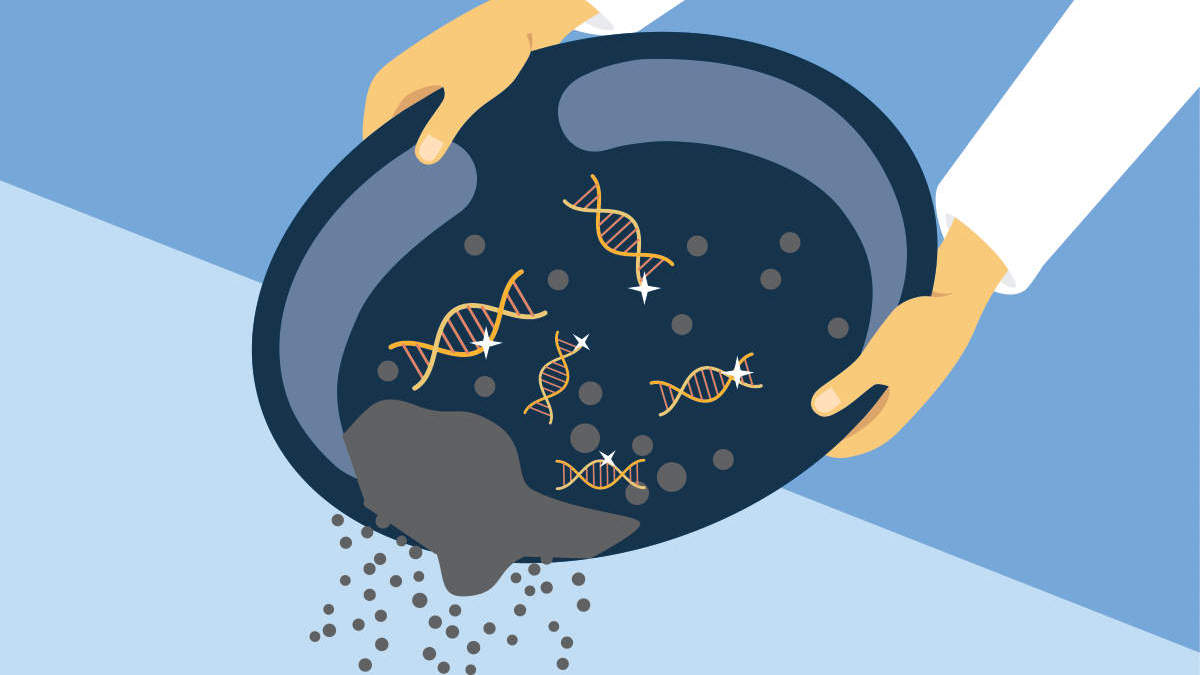
“Truth, like gold, is to be obtained not by its growth, but by washing away from it all that is not gold.” – Leo Tolstoy
Somewhere out there is a lab with a team of curious and meticulously driven scientists looking for variants associated with a specific cancer. Super excited about the potential impact of their research, they embark on a hunt for ultra-rare variants from circulating cell-free DNA (cfDNA) and circulating-tumor DNA (ctDNA). Studies have shown that these increasingly important biomarkers are known to correlate with disease progression and reoccurrence and may assist in therapy guidance. So finding these ultra-rare variants could be a significant step in their research journey.
But they hit a brick wall. The quest for ultra-rare variants is notoriously challenging and is akin to looking for a needle in a haystack.
The cfDNA is already highly fragmented and pre-analytical stabilization and isolation from biofluids is necessary. The low concentration of cfDNA limits the available concentration as a testing analyte to well below 20 ng. And because ctDNA represents just 1–2% of total cfDNA, as is the case in non-advanced, non-metastatic cancers, a limit of detection (LOD) below 1.0% is required. When it comes to limited samples, who’s got the time for trial and error? Plus, with the added pressure to publish, getting it right the first time is critical.
Once the team navigate these challenges and finally have a cfDNA sample they can work with and start sequencing, they encounter yet another set of obstacles: Sequencing reaction errors, enrichment biases and false positives. These further drive down the LOD requirement to 0.1% variant allele frequency (VAF).
If this scenario sounds familiar to you, there’s still hope and light at the end of the (research) tunnel. Somewhere out there is an ultra-rare variant just waiting to be discovered. With the right tools and technologies, that discovery could be yours.
Striking gold in your cfDNA samples – finding ultra-rare variants with confidence
With these challenges in mind, we’ve recently developed the QIAseq Targeted cfDNA Ultra Panels. Our panels allow you to detect ultra-rare variants down to 0.1% VAF from cfDNA. Worried about false positives? With our panels, you can achieve >99% specificity and dramatically drive down the false-positive rate. Best of all, you can go from sample to sequencing-ready library in just 8 hours with <2 hours of hands-on time. This means you arrive at your ‘eureka’ moment a lot quicker.
Use case study: Applying QIAseq Targeted cfDNA Ultra technology to detect variants associated with colorectal adenoma and cancer
A recent study on colorectal adenoma (AD) and cancer (CRC) examined cfDNA to identify specific variants associated with the high prevalence of colorectal cancer in Hungary (1). The study was aimed at gaining a comprehensive picture of the genetic variants in the exome characteristic of Hungarian patients with colorectal tumors. Matched plasma-originated cfDNA samples were also included in the study to evaluate the differences between colorectal cancer and adenomas by high-coverage exome sequencing in both tissue and plasma samples. Analysis of plasma cfDNA can be a relevant alternative for tissue biopsies because it can overcome intratumoral-heterogeneity-originated sampling errors (2). The researchers performed whole exome sequencing (WES) using the QIAseq Human Exome Kit with 10–50 ng cfDNA input. QIAseq Targeted cfDNA Ultra Panels were used for ultrasensitive targeted sequencing of cfDNA with hotspot coverage of AKT1, APC, BRAF, CTNNB1, DPYD, EGFR, FBXW7, GNAS, MAP2K1, NRAS, PIK3CA, RET, SMAD4 and UGT1A1, and with full exon coverage of ERBB2, KRAS and TP53.
With the targeted panel sequencing approach, they were able to identify 12/20 variants of all tumor somatic variants covered falling on its targeted regions. In contrast, whole exome sequencing of cfDNA from the same patients recovered only 20% of the tumor somatic variants in the respective regions.
The results highlight that WES of cfDNA can still be used as a viable alternative to tissue biopsies for detecting variants. However, when it comes to low-frequency variant detection, targeted sequencing using the QIAseq Targeted cfDNA Ultra Panels was more effective.
Unleash the full potential of your liquid biopsy analysis with targeted NGS
Liquid biopsies offer multiple advantages over traditional tissue biopsies. Typically quick and non-invasive, liquid biopsy approaches limit the need for surgical biopsy. They are particularly useful in detecting certain cancers, such as primary central nervous system lymphoma, where a tumor biopsy is difficult to obtain. Liquid biopsies allow the discovery of biomarkers for diseases such as cancer in biofluids such as blood and urine. However, harnessing the true potential of liquid biopsy relies on the right targeted NGS tools that can zone in on low-frequency variants of interest. Partner with us to benefit from our comprehensive solutions and expertise.
Useful resources to fuel your research
References
- Kalmár et al. (2023) Patterns of somatic variants in colorectal adenoma and carcinoma tissue and matched plasma samples from the Hungarian Oncogenome Program. Cancers (Basel). 15(3):907. doi: 10.3390/cancers15030907.
- Russano et al. (2020) Liquid biopsy and tumor heterogeneity in metastatic solid tumors: The potentiality of blood samples. J. Exp. Clin. Cancer Res. 39:95. doi: 10.1186/s13046-020-01601-2.